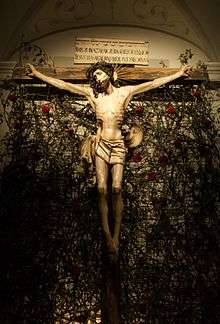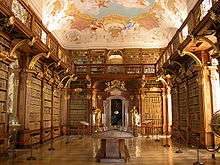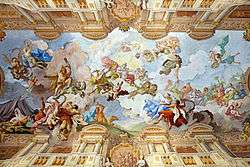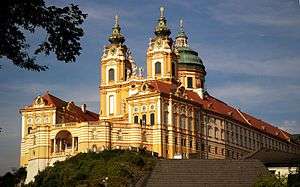Melk Abbey
| Melk Abbey | |
|---|---|
|
Native name German: Stift Melk | |
|
Melk Abbey | |
| Location | Austria |
| Coordinates | 48°13′41″N 15°20′02″E / 48.22806°N 15.33389°ECoordinates: 48°13′41″N 15°20′02″E / 48.22806°N 15.33389°E |
| Area | Europe |
| Architect | Jakob Prandtauer |
| Architectural style(s) | Baroque |
 Location of Melk Abbey in Austria | |
Melk Abbey (German: Stift Melk) is a Benedictine abbey above the town of Melk, Lower Austria, Austria, on a rocky outcrop overlooking the Danube river, adjoining the Wachau valley.[1] The abbey contains the tomb of Saint Coloman of Stockerau and the remains of several members of the House of Babenberg, Austria's first ruling dynasty.[2]
History
The abbey was founded in 1089 when Leopold II, Margrave of Austria gave one of his castles to Benedictine monks from Lambach Abbey. A monastic school, the Stiftsgymnasium Melk, was founded in the 12th century, and the monastic library soon became renowned for its extensive manuscript collection. The monastery's scriptorium was also a major site for the production of manuscripts. In the 15th century the abbey became the centre of the Melk Reform movement which reinvigorated the monastic life of Austria and Southern Germany.[3]
Today's Baroque abbey was built between 1702 and 1736 to designs by Jakob Prandtauer. Particularly noteworthy are the abbey church with frescos by Johann Michael Rottmayr and the library with countless medieval manuscripts, including a famed collection of musical manuscripts and frescos by Paul Troger.
Due to its fame and academic stature, Melk managed to escape dissolution under Emperor Joseph II when many other Austrian abbeys were seized and dissolved between 1780 and 1790. The abbey managed to survive other threats to its existence during the Napoleonic Wars, and also in the period following the Anschluss in 1938, when the school and a large part of the abbey were confiscated by the state.
The school was returned to the abbey after the Second World War and now caters for nearly 900 pupils of both sexes.
Since 1625 the abbey has been a member of the Austrian Congregation, now within the Benedictine Confederation.
In his novel The Name of the Rose, Umberto Eco named one of the protagonists "Adso of Melk" as a tribute to the abbey and its famous library.
Among its alumni was the 19th-century Austrian dramatist and short-story writer, Friedrich Halm.
Melk Abbey is also the metaphorical climax ("a peak in a mountain range of discovery") of Patrick Leigh Fermor's autobiographical account of his walking tour across pre-WW II Europe in "A Time of Gifts", which includes a description of the Abbey at that time. [4]
Euro commemorative coin

Melk Abbey was recently selected as the main motif of a 10 euro collectors' coin: the Austrian Melk Abbey commemorative coin, minted on April 18, 2007. The obverse shows a view up to the façade of the abbey church and its two side wings from a low level. The twin baroque towers and the great dome of the church behind them can be seen. In the lower right corner the coat-of-arms of the Abbey of Melk (the crossed keys of St. Peter) can be seen.
Gallery
- Melk Abbey
 Main entrance
Main entrance Prelate's courtyard
Prelate's courtyard Melk Abbey at night
Melk Abbey at night Melk Abbey at night from the old town
Melk Abbey at night from the old town Aerial view
Aerial view Leopold Altar, painting by Georg Bachman (1650)
Leopold Altar, painting by Georg Bachman (1650)- Choir stalls
- Pulpit
- The Ceiling
 Melk library
Melk library Staircase between the library and church
Staircase between the library and church Church of the Abbey
Church of the Abbey Frescoed ceiling of the church
Frescoed ceiling of the church Cupola of the church
Cupola of the church The Triumph of the Monk, by Johann Michael Rottmayr
The Triumph of the Monk, by Johann Michael Rottmayr- Melk Abbey
 Melk Abbey
Melk Abbey Margravine Swanhilde's altar, eleventh century
Margravine Swanhilde's altar, eleventh century St. Benedict's triumphal ascent to Heaven, also by Rottmayr
St. Benedict's triumphal ascent to Heaven, also by Rottmayr Painting on the ceiling of the marble hall
Painting on the ceiling of the marble hall Melk Abbey in 1672, before its renovation by Jakob Prandtauer.
Melk Abbey in 1672, before its renovation by Jakob Prandtauer. Euro commemorative coin
Euro commemorative coin
References
- ↑ "Melk, Niederösterreich". Encyclopedia of Austria. Retrieved 8 January 2013.
- ↑ Ellegast, Dr. Burkhard (1998). Melk Abbey. Melk: Stift Melk. p. 51. ASIN B000N48KHS.
- ↑ Toke, L. (1911). "Abbey and Congregation of Melk". The Catholic Encyclopedia. New York: Robert Appleton Company. Retrieved 8 January 2013.
- ↑ Fermor, Patrick Leigh (2005). A Time of Gifts: On Foot to Constantinople. New York, pp. 172–77.
External links
| Wikimedia Commons has media related to Stift Melk. |
